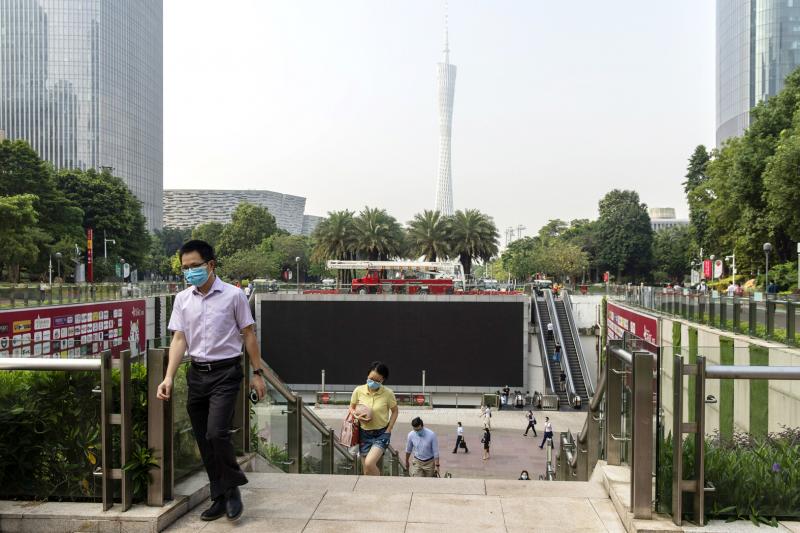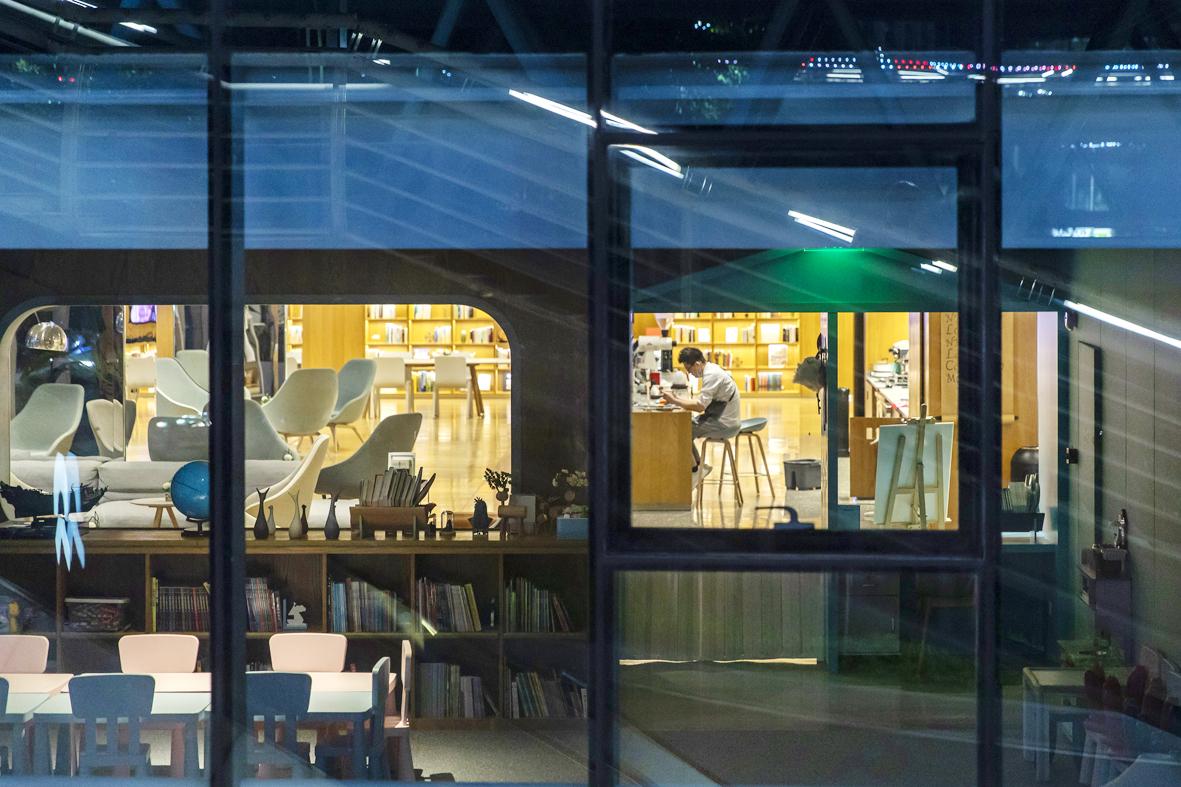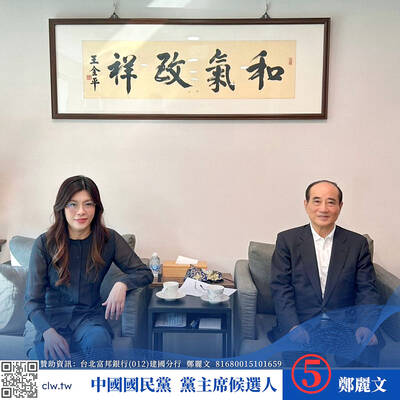At a new 400-acre research-and-development center on China’s south coast, Huawei Technologies (華為) engineers chat, tap at their phones, or chill out on a small electric tram that whirs them between buildings modeled variously on the Sorbonne or England’s great universities. They move through neighborhoods built in the style of Versailles or Renaissance Italy, passing by some of the 3,000 gardening and maintenance staff needed to keep the vast parklands immaculate.
It’s late July, and on this Disneyland-like corporate campus about an hour and a half’s drive from Hong Kong, Huawei seems to be basking in the wealth from its leadership in 5G mobile technology. No other company has done more to project the image of a technologically advanced China on the international stage. And no other company stands as a greater symbol of China’s engagement with the outside world.
XI JINPING’S GRAND VISION

Photo: Bloomberg
Huawei’s vaulting ambition to be at the forefront of future-defining technologies has landed the company in the crosshairs of the US and other governments that see it as a conduit for the geopolitical objectives of the Chinese Communist Party. In mid-August the US Department of Commerce, at President Trump’s direction, handed down yet another round of restrictions aimed at cutting Huawei’s access to commercially available computing chips it needs to make 5G base stations and smartphones.
The fortunes of China’s largest technology company by revenue are entwined with a vast project that’s now the front line of the hugely consequential tech war between the US and China: the Greater Bay Area (GBA), a region tasked by President Xi Jinping (習近平) with pushing the nation toward global technology leadership.
The GBA’s ability to innovate and integrate enough to succeed in that task is facing its stiffest challenge yet from a US-led global backlash against Chinese tech and Beijing’s political crackdown in Hong Kong. If the GBA’s companies can surmount the obstacles being placed in their path, they could well determine how advanced and prosperous China can become under Xi.

Photo: Bloomberg
The Pearl River Delta — long one of China’s richest and most economically dynamic regions and rebranded by Xi as the Greater Bay Area — stretches from the forested hills around Zhaoqing in the northwest to the concrete towers of Hong Kong Island in the southeast. It’s the epicenter of Xi’s strategy to attain high-income status, bind the former colonial centers of Hong Kong and Macao into the motherland, and complete what he calls the “rejuvenation” of the Chinese nation. He wants this region of about 70 million people to rival the clusters of Tokyo Bay or San Francisco-Silicon Valley and the role they play in driving innovation, entrepreneurship and growth.
Huawei reflects Xi’s grand vision for the Pearl River Delta. But as pressure from the Trump administration grows, executives of the company, which had a record US$122 billion in sales last year, show signs of recognizing the changing, narrowing world in which they’re now living.
Guo Fulin (郭福林), a two-decade veteran of the company who ran parts of its business in Europe and is now its president of international media affairs, deploys gnomic understatement to describe Huawei’s predicament.
“The star in the sky will shine either to the west or to the east,” he says, meaning there will be opportunities for Huawei whether the US slams the door shut or not. “We are not targeting every customer in the world. Customers who choose Huawei will eventually live better.”
With his actions — restricting sales of high-end semiconductors to Huawei, banning Americans from doing business with Tencent’s WeChat app — Trump threatened revenue and product development at China’s most innovative companies. The importance of that is magnified by the timing of his actions, which come as China is upgrading its industries, with many sectors still in need of expertise from abroad to complete the development Xi expects.
China’s leaders maintain their public commitment to the open, globalized world economy that’s benefited the nation so handsomely over the past two decades. But Xi is also adopting inward-looking ideas of self-sufficiency in a shift back to an industrial model less integrated into global supply chains. That’s not necessarily in China’s interest, says David Dollar, a former US Treasury emissary to the country who’s now a senior fellow at the Brookings Institution in Washington.
“The danger is if you feel you have to respond to the US protectionism with Chinese protectionism,” he says. “If you go down that road, then all this aspiration to become a more innovative economy is pretty hopeless.”
The Greater Bay Area strategy is rooted in an earlier time in Xi’s chairmanship that was all about China going out into the world through investment, acquisitions and geopolitical partnership-building through initiatives such as the “Belt and Road” enterprise. First mooted by Shenzhen local authorities in 2014, and then elevated into a central government policy blueprint unveiled last year, the plan outlines the ambition to build a tech hub to “target the most advanced technologies and industries in the world.”
PEARL RIVER DELTA
Far from Beijing and close to the open sea, the Pearl River Delta has long been China’s most mercantile and innovative place. The crowded islands that form Hong Kong and Macao remain separate jurisdictions even today, with their own laws, currencies and political traditions shaped by the legacy of British and Portuguese colonialism.
In Hong Kong, the differences between local society and the political culture across the border are a major source of friction, with hundreds of thousands of people in Hong Kong taking to the streets in often violent protests last year to push back against increased control by the Communist Party.
Standing among the futuristic towers of Shenzhen, just across the marshy borderland from Hong Kong, it’s easy to imagine the goal of technological leadership being within reach. In this city, mythologized as rising from a mere fishing village to a global metropolis within four decades, companies with a genuine claim to world leadership have their home.
More than a dozen Fortune Global 500 companies in the Guangzhou-Hong Kong-Shenzhen conurbation help drive a trillion-dollar economy that exports more than Japan does. The region spends double the national average on R&D, and Shenzhen alone accounts for more than a fifth of China’s high-end exports.
Huawei began in 1987 with its founder, Ren Zhengfei (任正非), repeatedly crossing the border, importing telephone switching gear from Hong Kong that he then resold to customers in China who were desperate for upgraded communications.
Today the employee-owned company has sales in about 170 countries. At its corporate headquarters in Shenzhen, lavish reception rooms for visitors are modeled on Japan’s old Kyoto, with refreshments intended to make executives feel at ease before being pitched for deals on telecom hardware.
But the list of nations that see Huawei as a proxy for China’s geopolitical ambitions is growing. Following the US lead, the UK is banning the company from its next-generation 5G networks and requiring that Huawei technology already installed in existing equipment be stripped out by 2027. Australia has shut the company out, as has Japan. India may curb Huawei and its tech neighbor in Shenzhen, ZTE Corp, from its networks as relations between the two states deteriorate.
This kind of tech decoupling could cost the world economy some US$3.5 trillion in wasted output over the next five years, according to a report in July by Deutsche Bank AG. The costs arise from extra R&D, demand disruption and supply chain rerouting that would become necessary if the current flow of know-how and parts — much of which already passes through China — shifts permanently.
That’s already happening at Huawei and, more broadly, in China. Huawei says that Trump sanctions enacted in May, which forbid companies using US technology from supplying the Chinese company, cut it off from about 2 percent of its imported parts, which can’t be sourced elsewhere. To be able to completely replace lost technology could take Huawei an additional five to eight years, it says; outside estimates point to 10 years or more. That’s “a big loss for us,” Yu Chengdong, chief executive officer of Huawei’s consumer business group, said publicly in August.
GOING IT ALONE
Chinese leaders have frequently said that pressure from the outside will make the nation redouble its efforts to catch up technologically. There’s evidence that a broad push is under way to increase research and design capacity. Initial public offerings by Chinese semiconductor companies had raised a record US$10 billion as of August as companies seek to localize supply chains.
That’s exactly the kind of duplication of effort that Deutsche Bank warns of, and there’s no guarantee that local companies can make up for what they’ve lost from the outside anytime soon. That could leave the GBA in the position of being a leading tech hub within and for China’s domestic market, but falling short of playing that role for the world.
Even as US actions have hurt some tech companies in the Greater Bay Area, the COVID-19 pandemic has boosted others. The headquarters of Shenzhen Mindray Bio-Medical Electronics is an appropriately clinical-looking, 35-story tower in Shenzhen’s Nanshan District. It manufactures, among other products, the SV800 and SV300 series of medical ventilators vital to treating patients severely affected by COVID-19.
The company’s three founders — including Li Xiting, a Singapore resident who was already the city-state’s second-richest man — had added about US$17 billion to their combined wealth this year as demand soared. Mindray Vice President Huang Haitao says the company, which plows 10 percent of revenue back into R&D, aims to break into the global top 20 of medical equipment companies and push the industry’s frontiers into automation and artificial intelligence.
But Mindray, which says its medical equipment is used in the Johns Hopkins Hospital in Baltimore and at Mayo Clinic campuses, may not be immune from US targeting forever. In August, as part of his presidential campaign, Democratic Party candidate Joe Biden vowed to end American reliance on Chinese medical equipment.
“Some parts of our equipment are manufactured in the US,” Huang says. “For the sake of supply chain safety, we’ll abide by all American and international laws. At the same time, we’re also actively developing backup plans, which include looking for alternative suppliers.”
Innovation in the GBA is driven largely by companies, not universities, making the pace of progress more susceptible to the business cycle and the fortunes of any individual company. There is no Berkeley or Stanford here. China’s best minds in science, technology, engineering and mathematics still graduate from Tsinghua and Peking universities in the capital and Fudan University in Shanghai, thousands of kilometers away.
That’s an issue singled out by Eric Guo, chief artificial intelligence scientist at Guangdong Oppo Mobile Telecommunications, the world’s fifth-largest smartphone manufacturer. The 36-year-old former Microsoft researcher has a PhD from Purdue University in Indiana.
Sitting in corporate offices soon to be superseded by headquarters designed by Zaha Hadid, Guo praises the quality of life in Shenzhen. He points out that branches of China’s top-flight colleges are coming to Shenzhen, but more needs to be done, because the beauty and efficacy of university research is that it’s not constrained by making money in the short term. “Universities are the engines of innovation,” he says.
HONG KONG
Less than 20 miles away, in central Hong Kong, it was university students who took to the streets last summer, protesting first against a law that would erode the legal separation between the former British colony and the mainland, and then more generally against Beijing’s rule over the city.
In many ways, Hong Kong is doing what it’s always done — getting on with doing business with China — and it’s still the funnel through which most foreign direct investment flows into the wider GBA. But large parts of its population now see closer ties with the mainland as anathema, and rising tensions have divided a community that might have been expected to help knit together the GBA’s future economy.
That doesn’t bode well for what many in the business community see as the best long-term growth opportunities for either Hong Kong or the Greater Bay Area.
“Hong Kong’s role is getting GBA companies to go global — a kind of adapter,” says Ben Simpfendorfer, founder of consulting firm Silk Road Associates. “Hong Kong needs to retain its connectivity to international markets.”
Beijing still pledges allegiance to the constitutional principle of “one country, two systems,” but the implementation of a national security law this past summer drew a quick response from the US, which removed a long-standing special trade privilege Hong Kong had enjoyed. That in itself “deepens pessimism” about the long-term business prospects in the city, according to a statement issued by the American Chamber of Commerce.
Policymakers in Beijing are plowing ahead with measures to ensure Hong Kong continues to play its role as the offshore financial center of the Greater Bay Area. The so-called Wealth Management Connect, for example, was announced in June, allowing residents in Hong Kong, Macao, and Guangdong to invest across the border.
But uncertainty is riding high. Nicholas Kwan, head of research for the Hong Kong Trade Development Council, stresses that without an open and connected business and political environment, the city can’t play its proper role in the broader strategy.
“We can’t just be part of China,” he says. “We also have to be part of the rest of the world.”
Some would say the same of the Greater Bay Area. As it was when Deng Xiaoping (鄧小平) opened the region to foreign investment four decades ago, China’s dynamic south has once more been handed the role of driving the nation’s rise. But in an era when China, like Huawei, is being challenged on all sides, grand economic growth projects like the GBA have no guarantee of success, and Xi’s plans for the region now hang in the balance.

We lay transfixed under our blankets as the silhouettes of manta rays temporarily eclipsed the moon above us, and flickers of shadow at our feet revealed smaller fish darting in and out of the shelter of the sunken ship. Unwilling to close our eyes against this magnificent spectacle, we continued to watch, oohing and aahing, until the darkness and the exhaustion of the day’s events finally caught up with us and we fell into a deep slumber. Falling asleep under 1.5 million gallons of seawater in relative comfort was undoubtedly the highlight of the weekend, but the rest of the tour

Youngdoung Tenzin is living history of modern Tibet. The Chinese government on Dec. 22 last year sanctioned him along with 19 other Canadians who were associated with the Canada Tibet Committee and the Uighur Rights Advocacy Project. A former political chair of the Canadian Tibetan Association of Ontario and community outreach manager for the Canada Tibet Committee, he is now a lecturer and researcher in Environmental Chemistry at the University of Toronto. “I was born into a nomadic Tibetan family in Tibet,” he says. “I came to India in 1999, when I was 11. I even met [His Holiness] the 14th the Dalai

Following the rollercoaster ride of 2025, next year is already shaping up to be dramatic. The ongoing constitutional crises and the nine-in-one local elections are already dominating the landscape. The constitutional crises are the ones to lose sleep over. Though much business is still being conducted, crucial items such as next year’s budget, civil servant pensions and the proposed eight-year NT$1.25 trillion (approx US$40 billion) special defense budget are still being contested. There are, however, two glimmers of hope. One is that the legally contested move by five of the eight grand justices on the Constitutional Court’s ad hoc move

Stepping off the busy through-road at Yongan Market Station, lights flashing, horns honking, I turn down a small side street and into the warm embrace of my favorite hole-in-the-wall gem, the Hoi An Banh Mi shop (越南會安麵包), red flags and yellow lanterns waving outside. “Little sister, we were wondering where you’ve been, we haven’t seen you in ages!” the owners call out with a smile. It’s been seven days. The restaurant is run by Huang Jin-chuan (黃錦泉), who is married to a local, and her little sister Eva, who helps out on weekends, having also moved to New Taipei